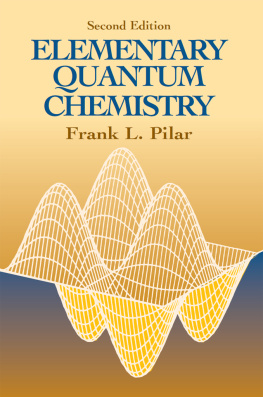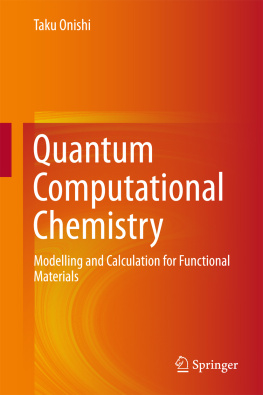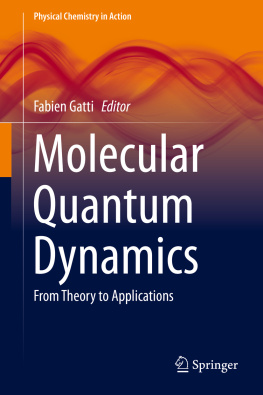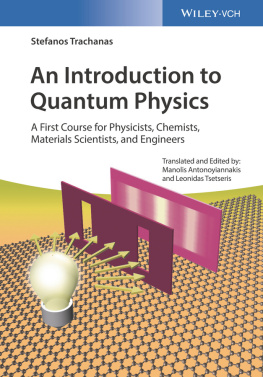Quantum Theory for Chemical Applications

Oxford University Press is a department of the University of Oxford. It furthers the Universitys objective of excellence in research, scholarship, and education by publishing worldwide. Oxford is a registered trade mark of Oxford University Press in the UK and certain other countries.
Published in the United States of America by Oxford University Press
198 Madison Avenue, New York, NY 10016, United States of America.
Oxford University Press 2021
All rights reserved. No part of this publication may be reproduced, stored in a retrieval system, or transmitted, in any form or by any means, without the prior permission in writing of Oxford University Press, or as expressly permitted by law, by license, or under terms agreed with the appropriate reproduction rights organization. Inquiries concerning reproduction outside the scope of the above should be sent to the Rights Department, Oxford University Press, at the address above.
You must not circulate this work in any other form and you must impose this same condition on any acquirer.
Library of Congress Cataloging-in-Publication Data
Names: Autschbach, J. (Jochen), author.
Title: Quantum theory for chemical applications : from basic concepts to advanced topics / Jochen Autschbach.
Description: New York : Oxford University Press, 2020. | Includes bibliographical references and index.
Identifiers: LCCN 2020021153 (print) | LCCN 2020021154 (ebook) | ISBN 9780190920807 (hardback) | ISBN 9780197508343 (epub)
Subjects: LCSH: Quantum theoryTextbooks.
Classification: LCC QC174.12 .A88 2020 (print) | LCC QC174.12 (ebook) | DDC 530.12dc23
LC record available at https://lccn.loc.gov/2020021153
LC ebook record available at https://lccn.loc.gov/2020021154
1 3 5 7 9 8 6 4 2
Printed by Integrated Books International, United States of America
Contents
Quantum Theory for Chemical Applications (QTCA)
Quantum theory or, more specifically, quantum mechanics is endlessly fascinating, curious, and strange, and often considered to be difficult to learn. It is true that quantum mechanics is a mathematical theory. Its scope, its predictions, the wisdom we gain from its results, all become fully clear only in the context of the relevant equations and calculations. But the study of quantum mechanics is definitely worth the effort, andas I like to tell my studentsit is not rocket science.
Quantum mechanics governs what electrons and nuclei do in atoms and molecules. The electrons form the molecular glue that we call chemical bonds. The quantum effects of the motion of electrons and nuclei are probed in spectroscopy and used in a great number of scientific and technological applications. Quantum mechanics is, therefore, the underlying physical theory for most of chemistry, and important parts of chemical engineering and materials science.
QTCA is written for students and practicing researchers with a background in chemistry, chemical engineering, or materials chemistry. The text is intended to be self-contained, such that only high school physics, college introductory calculus, and general chemistry (first-year college chemistry) are required. QTCA places special emphasis on the orbital models central to chemical applications of quantum theory. The book is suitable for a one-semester undergraduate or graduate course, with a selection of basic and advanced topics, depending on student backgrounds and needs, and instructor preferences. There is sufficient material in QTCA to cover a two-semester course sequence or a more advanced graduate course. The text is also suitable for self-study and includes chapters on mathematical and classical physics concepts that are helpful to understand quantum theory. The Appendix covers, among other topics, what I like to think of as basically all the linear algebra youll ever really need.
Quantum theory and computational chemistry are becoming increasingly important in chemistry, chemical engineering, materials chemistry, and other areas of science and technology that are related to chemistry. I wont specifically mention fields related to chemistry from here on and include them in an expansive definition of chemistry. Concepts of chemical bonding, band structure, materials properties, and interactions between light and matter at the molecular scale are almost always expressed in the framework of orbital theory, even if the calculations go beyond simple orbital models. Students of chemistry learn first about electron orbitals in general, organic, and inorganic chemistry, but often without realizing where these ideas come from or that there are numerous approximations underlying the linear combination of atomic orbitals (LCAO) molecular orbital (MO) theories that are used so successfully in chemistry. The record is supposed to be set straight in the first course on quantum theory.
Quantum theory is often taught in the undergraduate chemistry curriculum as follows: After providing justifications for the need of quantum theory (such as the problems with explaining the black-body radiation, the photoelectric effect, heat capacities, the stability of matter, or atomic spectra, with classical physics), and introducing the basic quantum theory formalism up-front or along the way, a series of increasingly complex problems is worked through: the Particle in a Box (PiaB), finite-depth boxes and barriers, two- and three-dimensional boxes, the harmonic oscillator, Morse oscillators, angular momentum, spin, the hydrogen atom, many-electron atoms, diatomic molecules, general molecules, and the foundations of spectroscopic techniques. The spectroscopy and term symbols of atoms and small molecules tend to be heavily emphasizedin particular, in older textsalong with vibrational/rotational spectroscopy, group theory, and molecular symmetry. Perturbation theory is discussed in varying levels of detail, or left out. Computational chemistry concepts also tend to be discussed at varying levels of detail, or not at all. When the topic finally turns to MO models, the important ideas tend to get drowned out among the other material, and student fatigue is palpable.
I decided to write a quantum theory textbook for chemistry that introduces MO theory earlywithout sacrificing rigorand highlights applications of orbital models to chemical problems before moving on to other topics. Importantly, I also wanted to make it very clear what electron orbitals are not. You will learn early on about common misconceptions related to electron orbitals and how to avoid them.
A practitioner of chemistry should be trained not only in basic quantum theory and spectroscopy, but also know how to decipher band structure and density-of-states plots for solid (crystalline) materials. Accordingly, QTCA includes a basic, but detailed, chapter on band structure concepts. Due to the rapid rise of nanoscience, in which systems have length scales where molecules start to acquire some periodic solid-like properties and extended systems start to exhibit molecule-like quantum behavior, it is very important that chemists working in these fields know not only the molecular limit of the theory, but also the band structure perspective. In my experience, someone who is trained in chemistry will find much of the condensed-matter physics literature inaccessible. QTCA aims to provide a bridge.
Furthermore, the past decade has seen a surge in theoretical studies of compounds with truly heavy elements such as lanthanides, heavy transition metals, and actinides. Much of the f-element research is currently driven by the tremendous interest in single-molecule magnetism and by the fascinating chemistry of 5f elements. The heaviest transition metals have a wide range of important applications, and who isnt fascinated by the properties of gold and mercury? Quantum theoretical calculations for compounds containing such heavy elements require an Einstein relativistic framework. Although this is a more advanced topic, the underlying principles are suitable for inclusion in a course of quantum theory for chemists at the undergraduate or beginning graduate level. Accordingly, QTCA features a chapter on relativistic quantum chemistry, with a focus on spin-orbit coupling (because of its practical importance in processes such as intersystem crossing) and on so-called exact two-component (X2C) methods (because of their rapidly rising use). Also, did you know that relativity starts your car?









